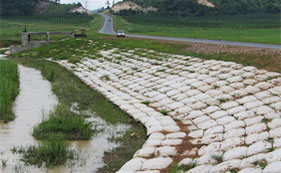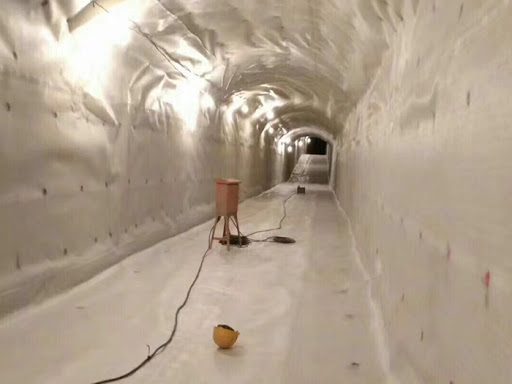
 Back to List
Back to List

There are generally three laying methods for tunnel waterproof boards in construction applications:
①Anchor fixing method (hot-melt pad anchor welding) ②Anchor-free laying method of hanging plastic waterproof board ③Concealed buckle fastening method (lacing suspension method). The first two kinds of paving sites are labor intensive and have relatively poor waterproof effect. At present, the hidden buckle fastening system (lace suspension method) is used for easy operation. The products produced by this production process are most suitable for concealed buckle tie hanging (lace suspension method), which can improve laying quality and efficiency in construction applications, convenient construction, low cost, save project investment, and improve project quality stability , Superior to hot melt anchor welding.
1. Concealed buckle fastening and hanging (lace hanging method)
(1) Rock surface treatment. Cut the exposed bolt heads and steel mesh heads at the same root, and smooth them with cement mortar. For the unevenness of the initial support surface, when the vector height/chord length>1/6, local leveling should be done. According to the size of the leveling range, the method of concrete spraying, mortar or partial hanging slab moulding is selected for leveling, and it is qualified until the height of the arrow/chord is greater than 1/6. The purpose of this is to prevent the local bumps of the waterproof board from being broken when the concrete is poured.
(2) Tailor welding before hanging. Lay the narrower rolls of factory-finished products on the ground, and tailor-weld them into large-format coils that are easy to transport and hang. When tailor welding, the geomembrane surfaces of the two composite geosynthetics should be welded together. It is not allowed to weld the surface of the geomembrane and the surface of the geotextile together to prevent the fissure water from penetrating through the capillary of the geotextile along the joint, causing water leakage. The width of the overlapped joint of tailor-welded joints shall not be less than 100mm. Welding is not allowed to have missing welding or false welding. Any scorching or welding penetration must be covered with plastic sheet solder paste. The welded large-format waterproof material is placed in rolls for later use. The geotextile faces outwards.
(3) The suspension of waterproof materials. Adopt the suspension method of "from bottom to top" and "test shop positioning".
"From bottom to top" means that the waterproof material is first spread up from the foot of the wall on both sides, and finally closed at the vault. This method is more suitable for large-section tunnels with high headroom, large amount of waterproof material and heavy coils. , Because with the continuous improvement of the laying position, the coil is gradually opened and its weight is getting lighter and lighter, which is convenient for high-altitude operations.
The suspension process of "trial positioning" is as follows: gradually unfold the waterproof membrane and hold it against the initial support surface. When the sling on the non-woven fabric is attached to the initial support surface, stop and make a mark, and then place the support Put down part of the waterproof material, drill an eye with an electric drill at a fixed position, with a depth of about 100mm, nail in a small wooden pile with a fine lead wire in advance, and cut off the part higher than the initial support surface. A row of piles at this height After all the nails are finished, turn up the waterproof material again and close it to the initial support surface, and fasten the strap with the lead wire firmly. Along the ring direction, use the same method to suspend the lower row of waterproof material slings, go straight to the vault, and then hang another large waterproof board. In order to speed up the progress, several pieces of waterproof materials can also be laid at the same time and operated in parallel. The length of the waterproof material spreading along the tunnel direction is about 1m longer than the length of the concrete poured this time, so that on the one hand, it is convenient to connect with the waterproof material of the next tunnel section, and on the other hand, the joint of the waterproof material can be staggered with the concrete construction joint About 1m, it helps to prevent water leakage at the concrete construction joints.
(4) Follow-up after shop. Weld the joints between the paved pieces of waterproof material.
(5) Protection of waterproof materials. When the lining is excavated closely, the waterproof material reserved at the end of the lining shall take protective measures to prevent the flying stone from breaking the waterproof material when the support surface is shot. The installation of lining reinforcing steel bars, the installation of various embedded parts, the installation of the retaining diaphragm, the positioning of the concrete conveying pipeline and the infusion of concrete, etc., are likely to break, pierce or burn through the geotechnical template. Once the geomembrane is damaged, it should be repaired immediately.
2. Ensuring the integrity of the seams is a prerequisite for ensuring effective isolation and long-term work of the geomembrane.
(1) Welding method of geomembrane
Relying on the effect of heat, the surfaces of the two geomembranes are melted at the same time, and under pressure, they are cooled to combine them into a whole, which is called the welding of geomembranes.
Thermoplastics can be welded.
Electric soldering iron welding method, use an electric soldering iron welding machine to overlap the film 50-60mm, underlay a wood or steel plate, and move along the seam. The electric soldering iron will heat and melt the film, and the two overlapped films will be welded as the roller is processed. Into one.
(2) Welding quality control: advantages of hot body welding method:
① No need to roughen the surface of the film
② During the welding process, no new substance is added to form the weld.
③ Its heat source control is separated from PE membrane.